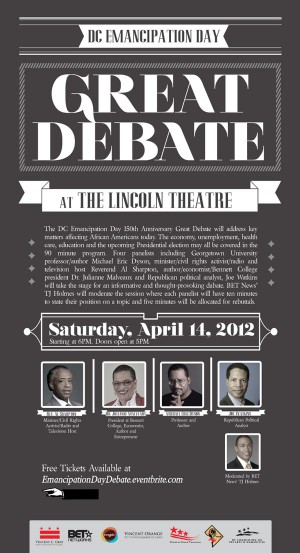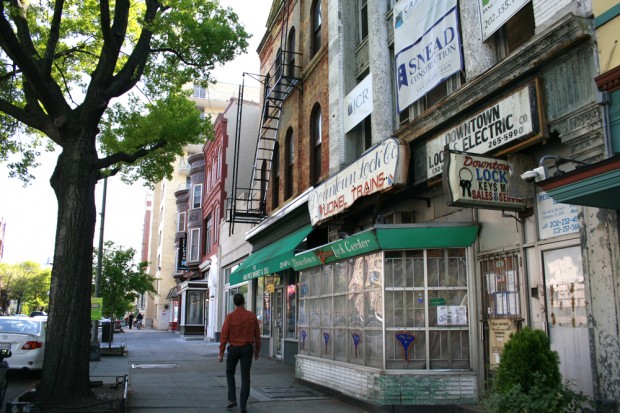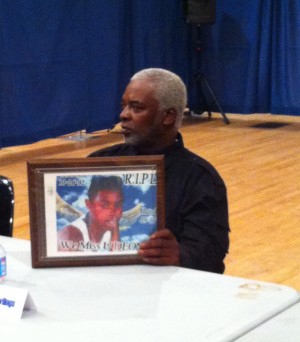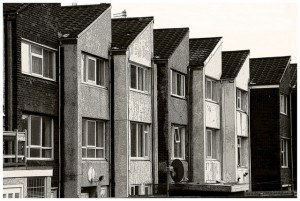The Trayvon Martin case has reignited a national conversation on race, with writers, bloggers and pundits all weighing in on racial profiling and the inequities in the criminal justice system. But social commentator Mychal Denzel Smith argues that such debates fail and they do little to further understanding and end racism. Instead, he writes, constant, informed dialogue is needed. What do you think is necessary to have in order for conversations on race to be effective?
Author Archives: Elahe Izadi
Why Diversity Increased In African-American Neighborhoods
A rise in Hispanic and Asian neighbors has changed the racial makeup of neighborhoods where the average black person lives, Margery Turner of think tank Urban Institute writes. Meanwhile, the percentage of white people in these neighborhoods hasn’t changed that much over the past 30 years, Turner notes. Take a look at these charts showing the racial breakdown of neighborhoods where the average black person lived in 1980 and today.
Continue reading
Emancipation Day: The History And The Legacy
Today marks Emancipation Day in the District, commemorating the 150th anniversary of the day slavery ended in D.C. Today’s events will include historical activities and a parade focused on D.C. statehood. In 2007, then-mayor Adrian Fenty declared that Emancipation Day celebrations would be dedicated to the fight for D.C. statehood, an example of how the legacy of slavery has been tied to today’s push for full Congressional representation.
The District of Columbia Compensated Emancipation Act became law on April 16, 1862, nine months before President Abraham Lincoln signed the Emancipation Proclamation. About 3,000 enslaved people lived in D.C. at the time. The law provided compensation to former slave owners but no compensation to former slaves. A commission was set up to assess the monetary “value” of each slave and how much should be paid out to slave owners. National Archives expert Damani Davis tells the Washington Post that the District’s records are unusual for the level of personal detail they include about the formerly-enslaved.
D.C.’s Pay Gap Between Women Of Color And White Men

Victor1558 / Flickr
The table below compares how much the average woman earns to how much the average man earns, broken down by race:
| Women/Men | Black women/white men | Hispanic women/white men | White women/white men |
|---|---|---|---|
| 91 cents/$1 | 51 cents/$1 | 41 cents/$1 | 79 cents/$1 |
D.C. has one of the lowest overall wage gaps when compared to other states and the national average of 77 cents on the dollar. But comparing D.C. to other states is an apples-and-oranges kind of comparison, so NWLC senior policy analyst Katherine Gallagher Robbins sent us the statistics of nearby cities to get a sense of how the District fares.
The gap in pay between men and women in D.C. is the second smallest among Philadelphia, Baltimore, Boston, Atlanta and New York City (which came in first, with 93 cents on the dollar). But take race into account, and D.C. doesn’t do so well anymore; of the aforementioned cities, only Atlanta has a larger pay gap between minority women and white men. In the Georgia city, black and Hispanic women make about 42 cents for every $1 white men earn.
Increasing college degrees among black and Hispanic women in D.C. could help make a dent in the wage gap — 23 percent of D.C.’s black women hold at least a bachelor’s degree and 35 percent of the city’s Hispanic women hold such degrees, while 86 percent of white men do, according to census estimates. But even the average college-educated woman in D.C earn 12 cents less than the average college-educated man, according to NWLC.
(Video) Race And Class Intersecting On H Street NE
What do new and longtime residents have to say about the gentrification of H Street NE? A few residents talk about class, race and development in the video below, produced by the Poverty and Race Research Action Council, a nonprofit civil rights policy organization.
A few longtime residents are heartened by the changes along the corridor, while others are weary. The video closes out with a development sign on Florida Avenue NE (quite a distance away from H Street) that reads “Pretty soon, you won’t recognize the place. Promise.”
Determining the winners and losers in gentrification isn’t always so cut and dry. For example, a newer resident in the video said it’s a sign of the times that a longtime, black-owned suit shop went out of business after 40 years. She is probably referring to George’s Place at 10th and H Streets. Owner George Butler told us that the H Street streetcar construction, the recession and online competition led him to call it quits. But he is also 73 years old and owned his building, which he sold for a hefty price. Nizam and Kamal Ali of Ben’s Chili Bowl — a Washington institution — reportedly bought the building.
Anyway, take a look at the video and let us know: what thoughts do you have on how race and class intersect on H Street? Do you see people of different backgrounds interacting with one another?
DCentric Picks: Emancipation Day Great Debate
 What: D.C. Emancipation Day Great Debate
What: D.C. Emancipation Day Great Debate
When: 6 p.m., Saturday
Where: The Lincoln Theatre, 1215 U St. NW
Cost: Free, but you should register here.
Why you should go: The debate is just one of a number of D.C. Emancipation Day activities taking place throughout the week (the actual day is on April 16). The event is a callback to the Lincoln-Douglas debates of 1858, a series of seven debates that took place between then-Republican Senate candidate Abraham Lincoln and incumbent Sen. Stephen Douglas. Slavery loomed large in those debates.
D.C.’s “Great Debate” will focus on issues affecting today’s black community, such as unemployment, the economy, healthcare and the 2012 presidential race. Panelists include Michael Eric Dyson, activist Rev. Al Sharpton, author Julianne Malveaux and Republic political analyst Joe Watkins.
Other events to consider: Seven major Asian American poets, writers and playwrights will present new work on Saturday at the National Portrait Gallery as part of “Asian American Portraits of Encounter Between Image and Word.” The new writings were commissioned as a response to the museum’s first major exhibition of Asian American visual artists. Tours of the exhibit start at 11:15 a.m., and the readings start at 12:15 p.m. The day will also include panels and book signings.
From Locksmiths To Luxury Condos: Businessman Talks 14th Street Evolution

Elahe Izadi / DCentric
Downtown Lock Co. (center) has been on 14th Street since 1910. The building has been sold to make way for luxury condominiums along a street that's experiencing rapid redevelopment.
The evolution of 14th Street NW continues with regular announcements of new upscale restaurants and residences opening up along the corridor. But 14th Street wasn’t always the epicenter of fine dining in the District; in recent decades, it was more well-known as a place where drug dealers and prostitutes congregated.
A few older businesses still remain along the strip, but they’re starting to close shop, too. Take Downtown Lock Co. at 1345 14th St. NW, the building sold to make way for five, ultra-luxury condos.
“Back when we were there, the street had a lot of drugs, prostitution, a lot of drifters,” said Downtown Lock Co. co-owner Reuben Houchens. “You had to sort of establish yourself, first of all, that you weren’t afraid to be there. Of course we weren’t. [The way] we grew up, as we used to say, we knew the streets. And you had to basically hold your ground, as far as ‘we’re here and we will only tolerate so much.’ I’m talking about the pimps prostituting the girls, and drugs addicts and drug pushers — you had to be tough.”
Survey: Waiters At Large Chains Give Poor Service To Blacks
Black customers who frequently eat out are likely to experience discrimination at some point over the course of a month, according to a study published in the Journal of Black Studies. Sociologists from Wayne State University and North Carolina University surveyed 200 waiters at large chain restaurants, 87 percent of whom are white. Many of those surveyed looked down on black customers, reports the Washington Examiner (which also curiously has a photo of Ben’s Chili Bowl accompanying the story about large chain restaurants).
Do you think discrimination is a problem in D.C.’s restaurants?
Trayvon Martin Case Inspires Discussion Of Racial Profiling In D.C.

Elahe Izadi / DCentric
Charles Rawlings holds a photo of his son, DeOnte, who was shot and killed by off-duty police officers.
The Trayvon Martin case has spurred conversations in communities across the country over racial profiling and unequal treatment in the criminal justice system. Del. Eleanor Holmes Norton convened a D.C.-specific meeting Tuesday night, where she also announced that she plans to introduce a bill reestablishing a federal grant program for states to focus on racial profiling.
The program would pay for developing state anti-racial profiling laws, collecting data on traffic stops, training police officers and running fashion programs meant to reduce racial profiling. A similar grant program ended in 2009.
The Tuesday night forum by Norton’s D.C. Commission on Black Men and Boys was meant to “focus on eliminating the branding of African American boys and men on sight as criminals or in other negative ways,” Norton said.
There are a number of stories similar to the Trayvon Martin case, but not all have received the same level of national attention. In D.C., one of the most notable such cases is the 2007 death of 14-year-old DeOnte Rawlings, who was shot in the back of the head by two off-duty police officers after the boy allegedly stole one of the cop’s minibikes. The officers were never charged with a crime, and the family received a settlement over a civil lawsuit filed against the city.
Charles Rawlings, DeOnte’s father, said during the forum that his heart goes out to the Martin family.
“When you lose a child and when you’re alone, people don’t know what you’re going through,” Rawlings said. “It’s so painful that he’s not here anymore… My pain [doesn't] ever go away.”
Is A ‘World-Class City’ Code For An ‘Upper-Class City?’
Renters, unlike homeowners, are quite vulnerable to being priced out when neighborhoods undergo revitalization. That’s why D.C. nonprofit Manna has launched a campaign to increase affordable homes for low-income residents to buy. The group is focusing its efforts east of the Anacostia River, which has some of the most affordable neighborhoods to buy a home. But that may not last, given all of the development slated for the area.
Washington Post’s Courtland Milloy profiles Manna founder Jim Dickerson, who talks about how to close the gap between the rich and the poor in D.C. Dickerson says, “Instead of spending money trying to make poor people comfortable in poverty, we could be using homeownership to help liberate them.”






